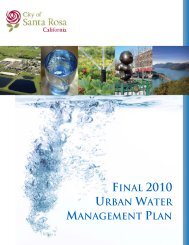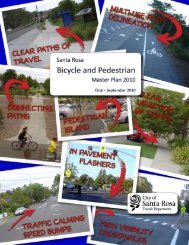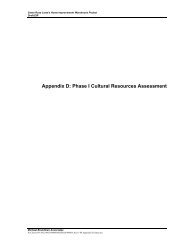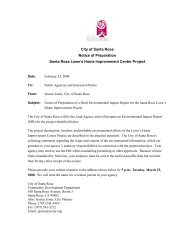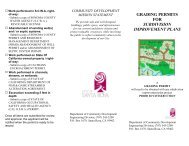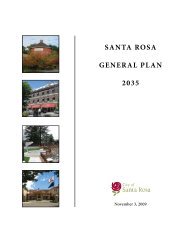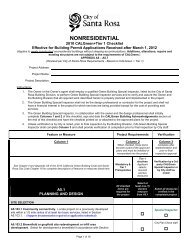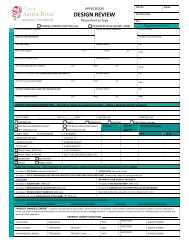Fountaingrove Environmental Impact Report - City of Santa Rosa ...
Fountaingrove Environmental Impact Report - City of Santa Rosa ...
Fountaingrove Environmental Impact Report - City of Santa Rosa ...
Create successful ePaper yourself
Turn your PDF publications into a flip-book with our unique Google optimized e-Paper software.
2.0 LIST OF COMMENTERS AND RESPONSE TO COMMENTS<br />
will be included as a condition <strong>of</strong> Project approval. The crossing would be a raised<br />
speed table marked as a pedestrian crossing equipped with a pedestrian-activated<br />
flasher, located on Thomas Lake Harris Drive between the Flats Building and<br />
Employee Housing (Lot 3).<br />
38) No specific comment was made. Potential impacts to emergency access are<br />
addressed in <strong>Impact</strong> 3.7-4, no significant impacts would occur. As noted in<br />
<strong>Impact</strong> 3.13-4 <strong>of</strong> the Draft EIR, the installation <strong>of</strong> a signal at the intersection <strong>of</strong><br />
Thomas Lake Harris and <strong>Fountaingrove</strong> Parkway will improve emergency access to<br />
and from the site.<br />
39) The state <strong>of</strong> California has published a technical advisory to provide guidance on<br />
addressing climate change in CEQA review (Office <strong>of</strong> Planning and Research, CEQA<br />
and Climate Change: Addressing Climate Change through California <strong>Environmental</strong> Quality<br />
Act (CEQA) Review, June 19, 2008). The guidance suggests that a Project’s greenhouse<br />
emissions be quantified and their significance be determined; it does not direct that<br />
climate change effects on water supply or other utilities be evaluated. The Project’s<br />
contribution to cumulative climate change effects is discussed in Section 3.3 Air<br />
Quality in the Draft EIR and in Response to Comment Public Hearing – 58.<br />
Operation <strong>of</strong> the Project may result in a net positive benefit for operational<br />
greenhouse gas emissions.<br />
Section 15145 <strong>of</strong> the CEQA Guidelines states that if a lead agency finds that a<br />
particular impact is too speculative for evaluation, this conclusion should be noted<br />
and no further discussions is required. The Climate Action Team <strong>Report</strong> to Governor<br />
Schwarzenegger and the Legislature (California <strong>Environmental</strong> Protection Agency,<br />
March 2006) analyzed the effects <strong>of</strong> potential climate change scenarios on<br />
California’s weather, among other areas. The report states that “There is no clear<br />
trend in precipitation projections for California over the next century. However the<br />
consensus <strong>of</strong> the recent Intergovernmental Panel on Climate Change (IPCC) model<br />
projections, including several models that were not selected for the present study, is<br />
for relatively little change in total precipitation, with a tendency toward a slightly<br />
greater winter and lower spring precipitation” but that “[h]igher temperatures will<br />
result in more precipitation as rain instead <strong>of</strong> snow and earlier melt <strong>of</strong> the snow that<br />
does fall…Declining snowpack will aggravate the already overstretched water<br />
resources in California. The snowpack in the Sierra Nevada provides natural water<br />
storage equal to about half the storage capacity in California’s major man-made<br />
reservoirs. The snowpack holds the winter precipitation in the form <strong>of</strong> snow and,<br />
historically, has released it in the spring and early summer as the snow melts. This<br />
loss in storage could mean more water shortages in the future. However, the full<br />
effect <strong>of</strong> this storage loss will depend in part on whether reservoirs can be managed<br />
to capture the earlier snowmelt while loosing flood control capacity.” The climate<br />
change scenarios vary widely in their potential consequences on snowpack, and the<br />
ability <strong>of</strong> water agencies around the state to store greater rainfall quantities will<br />
depend on how much additional storage is constructed and how storage is operated.<br />
Therefore, a reasonable estimate <strong>of</strong> effects <strong>of</strong> climate change on the <strong>City</strong>’s water<br />
supply cannot be made, and no further discussion is required. As described in<br />
Section 3.14 <strong>of</strong> the Draft EIR, the SCWA provides the <strong>City</strong> with its potable water<br />
ES092008001PHX\BAO\082970001 2-155



